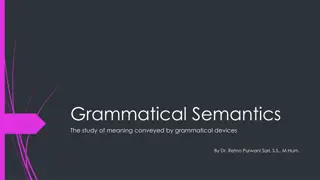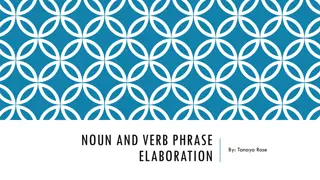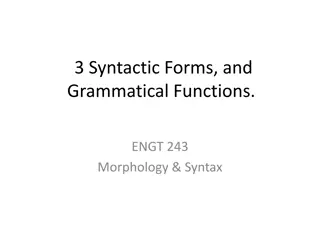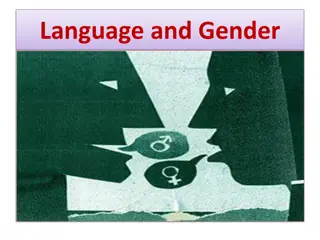Exploring Grammatical Gender in Language Across Cultures
Explore the concept of grammatical gender, the sorting of nouns into classes reflected in words associated with them. Discover how gender varies globally, impacting sound, form, and meaning. Dive into the fascinating relationship between grammatical gender and human cognition.
Download Presentation

Please find below an Image/Link to download the presentation.
The content on the website is provided AS IS for your information and personal use only. It may not be sold, licensed, or shared on other websites without obtaining consent from the author. Download presentation by click this link. If you encounter any issues during the download, it is possible that the publisher has removed the file from their server.
E N D
Presentation Transcript
Masculine, Feminine, Neuter, Vegetable Grammatical Gender around the World Ruth Kramer The Christina Kakava Linguistics Speaker Series
What is Grammatical Gender? feminine fourchette fork la fourchette the fork couteau knife le couteau the knife masculine French
What is Grammatical Gender? Gender is the sorting of nouns into two or more classes, as reflected in the form of words associated with the noun. La petite fourchette the small fork the small fork Le petit couteau the small knife the small knife
Why is Gender Interesting? Gender varies widely across languages. Gender affects sound, form, & meaning. How nouns are classified gives us clues about the nature of human cognition.
Outline Question 1: Can we predict the grammatical gender of a noun from its meaning? Yes! Question 2: What semantic properties of a noun can be used to predict its grammatical gender? TBD!
Outline, continued Question 3 (Big Picture): Why is grammatical gender related to meaning? Question 4 (Big Picture): What is the impact of these results for human cognition?
Q1: Gender Predicted from Meaning? Knife Fork Masculine couteau Feminine fourchette Hypothesis: there seems to be no connection between the meaning of a noun and its grammatical gender. French Feminine mindi Masculine mudac Somali Feminine cyllell Feminine fforc Welsh Masculine cuchillo Masculine tenedor Spanish
Q1: Gender Predicted from Meaning? Father Mother Revised hypothesis: the grammatical gender of a human noun can be predicted from its meaning. Masculine p re Feminine m re French Masculine aabbe Feminine hooyo Somali Masculine tad Feminine mam Welsh Male Masculine Female Feminine Masculine padre Feminine madre Spanish
Q1: Gender Predicted from Meaning? But some languages have human nouns with fixed grammatical gender. Spanish persona individuo person (feminine) individual (masculine) In the face of conflicting information, what s a linguist to do? French sentinelle g nie sentry (feminine) genius (masculine)
Defining the Observations Grammatical gender is assigned arbitrarily for some nouns (like knife and persona). arbitrary gender assignment Grammatical gender is assigned according to meaning for other nouns (like mother ). semantic gender assignment
Defining the Observations In Spanish and French, most human nouns undergo semantic gender assignment. Nouns like persona are exceptions. Is there any language where all nouns are assigned gender semantically?
Gender Assignment in Tamil is Semantic All nouns denoting women are feminine. pe woman kaa i Kali Tamil is a Dravidian language, spoken in India All nouns denoting men are masculine. aa man civa Shiva All other nouns are neuter. maram tree vii u house Other languages like Tamil: Mangarayi (Australia), Alamblak (Papua New Guinea), Zayse (Ethiopia), Barasano (Colombia), etc.
Semantic & Arbitrary Gender Assignment across Languages Only semantic gender assignment Tamil, Mangarayi French, Spanish Semantic and arbitrary gender assignment Only arbitrary gender assignment ??? Is there any language where all nouns are assigned gender arbitrarily?
Answer to Question 1 Every language with grammatical gender assigns gender semantically to at least some of its nouns. Every language has a semantic core to its gender system (major empirical discovery!) Q1: Can we predict the grammatical gender of a noun from its meaning? Yes, for at least some nouns in every language
What About Question 2? Q2: What semantic properties of a noun can be used to predict its grammatical gender? Answer so far: biological sex (female/male) Languages vary in which nouns are sex-differentiable: Just humans (Tamil) Humans and certain animals (Spanish, French) Humans and all animals (Amharic)
It is very common to use biological sex for semantic gender assignment. Types of Semantic Gender Assignment 90 Number of Languages 80 70 60 50 40 30 20 10 0 Sex-based Gender Assignment Other Gender Assignment What do the languages in the righthand bar use to assign gender? Animacy!
Animacy Example: Lealao Chinantec Lealao Chinantec has two genders: (1) -i/-y suffix on adjectives, verbs, etc. (2) no suffix on adjectives, verbs, etc. Lealao Chinantec is an Otomanguean language, spoken in Oaxaca, Mexico Nouns denoting men and women both occur with -i/-y, so these nouns have the same gender. nak -i m fallen the.woman The woman was made to fall. Mahu-i hmii m liu died father of.child The child s father died.
Animacy Example: Lealao Chinantec Nouns denoting animals occur with the -i/-y suffix. ds dx -y dog good good dog m h dx clothing good good clothing But nouns denoting objects do not.
Animacy Example: Lealao Chinantec Overall: Gender assignment in Lealao Chinantec is based on animacy, not biological sex. Animate Inanimate no suffix -i/-y suffix Better Answer to Question 2: What semantic properties are relevant to gender assignment? Biological sex or animacy But that s not all!
Some languages have more than 2 or 3 genders. 80 Number of Languages 70 60 50 40 30 20 10 0 2-3 Genders >3 Genders In addition to biological sex/animacy, some of these languages use other semantic properties for gender assignment.
Mayali Has Four Genders Mayali is a Gunwinjguan language, spoken in Australia Masculine nakurrng son-in-law Feminine daluk woman Neuter kunwarre muddy ground Vegetable mandubang ironwood tree
Gender in Bantu Bantu languages are spoken throughout sub- Saharan Africa. Bantu languages typically have 7-10 genders marked by prefixes on the nouns referred to with numbers Gender 1/2 is semantically assigned to human nouns. Swahili (G42) mtu mwenzi msichana person friend girl Some of the other genders are also assigned semantically. What properties are relevant?
Gender in Bantu Gender 3/4 is for plants. miti trees, mizizi roots Gender 7/8 is for tools kijoko spoon, kisu knife Gender 9/10 is for animals. mbwa dog, nyoka snake Gender 6 is for mass nouns. maziwa milk, maji water Gender 14 is used for abstract nouns uhuru freedom, ukweli truth Many exceptions!
Answers to Questions 1 and 2 Every language assigns grammatical gender to some of its nouns based on animacy or biological sex. In addition, some languages assign gender semantically to nouns based on other semantic properties (plants, tools, animals, mass nouns, etc.). Only the big picture questions remain: Q3: Why is gender always assigned semantically? Q4: What is the larger impact of this discovery?
Introduction to Inflection Class Inflection class: another type of noun classification Russian Subject Object Possessor Indirect object Class 1 zakon zakon zakona zakonu law Class 2 kola kolu koly kole school Class 3 kost kost kosti kosti bone Class 4 vino vino vina vinu wine
Inflection Class, continued Inflection class membership in Russian is not determined by any semantic property of the noun. Semantic features on a noun stem do not suffice to predict its inflection class, that is, none of the four inflection classes correlates unambiguously with a semantic property. (Alexiadou and M ller 2008) In fact, inflection class membership is never determined by meaning across languages.
Agreement We saw earlier that the grammatical gender of a noun affects the form of words associated with the noun. la fourchette the fork The definite article agrees with the noun in grammatical gender. le couteau the knife Noun = Controller Definite article = Target Inflection class never behaves like this. There is no agreement in inflection class.
Agreement, continued When a target & controller agree, they agree in a certain feature. this dog these dogs The demonstrative (target) agrees with the noun (controller) in number (sg/pl) The number feature onthe controlleris meaningful but the number feature on the target is not. Independent Hypothesis: Agreement in a feature F requires at least some potential controllers to be meaningful for that feature.
Why Gender Assigned Semantically? Answer: gender involves agreement, and agreement in a feature (gender) requires that feature to be meaningful on some nouns Two types of noun classification: Inflection Class Gender Involves agreement Meaningful for at least some nouns No agreement Not meaningful on any noun
Noun Classification in Language Types of Noun Classification Involves agreement? Meaningful on some nouns? Gender Y Y Inflection class N N Cannot exist! Y N Classifiers N Y Jacaltec (Mayan) xil naj xuwan no7 lab a saw CL.MALE John CL.ANIMAL snake John saw the snake.
Gender and Human Cognition Assumption: Language is a cognitive capacity. It is learned during a critical period Speakers are largely unconscious of their ability to use it Yet speakers use it very well It can be impaired by injury to the brain Thus: the semantic properties that are used to assign gender are important to human cognition.
Gender and Human Cognition: Key Questions Why are these properties important and not others (color, flammability, etc.)? Are these properties distinguished by infants and children? By non-human primates? By animals? Does this result match with other research on semantic properties in human cognition?
Gender and Human Cognition Hypothesis: conceptual knowledge is organized in the brain by the properties used to assign gender. Evidence: brain injuries can selectively impair the ability to recognize entities with these properties impairment for animate entities impairment for animals impairment for plants TBD: impairment just for humans? Just for male/female entities? Mass nouns? Abstract nouns?
Conclusions Answer to Question 1: Every language assigns grammatical gender to at least some of its nouns based on their semantic properties. Answer to Question 2: These properties include biological sex or animacy as a minimum, and can also include plants, tools, animals, mass nouns, etc.
Conclusions, continued Answer to Question 3: Gender is assigned semantically to at least some nouns because gender is defined by agreement. Answer to Question 4: The semantic properties used to assign grammatical gender may correspond to the categories of conceptual knowledge in the brain.























